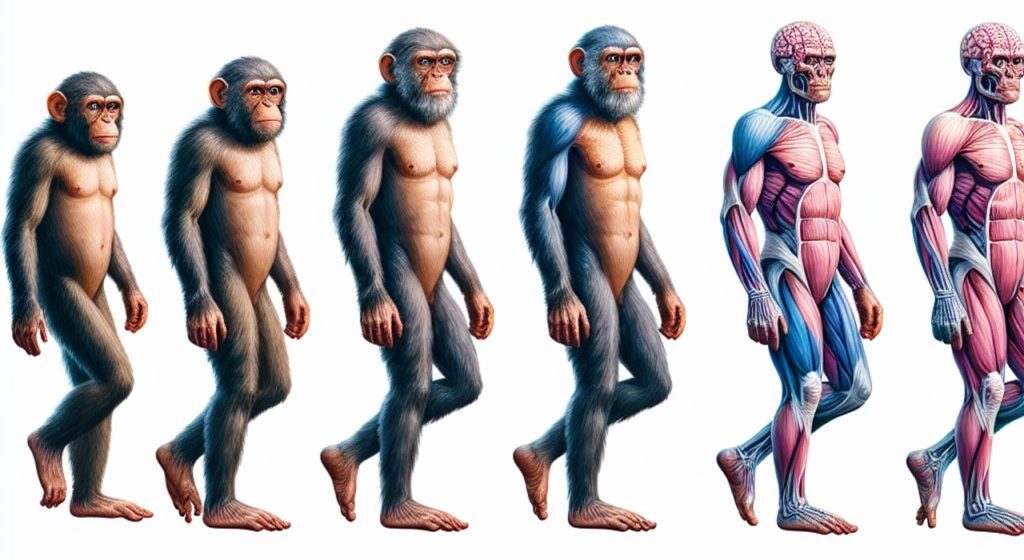
The question of who was the first person on Earth is a very interesting one. Philosophers are discussing this question, people in the bar after a few beers also, and scientists dabbled with this question for hundreds (if not thousands) of years.
Yet, do we have an answer? Can we even find an answer?
Let’s explore more.
Related:
From a scientific perspective, the first humans are believed to have evolved from earlier hominids such as Homo erectus, a species that lived between 1.9 million and 70,000 years ago.
However, the distinction between Homo erectus and Homo sapiens, the species to which modern humans belong, is not exactly clear-cut.
Additionally, one of the most famous fossils of a human ancestor is Lucy, a 3.2-million-year-old skeleton discovered in Ethiopia in 1974. Lucy is believed to belong to the species Australopithecus afarensis, which is not a direct ancestor of Homo sapiens but somehow a close relative.
Namely, Lucy has been formally categorized as a hominid, representing a precursor to humanity. Her species eventually gave rise to Homo habilis, then followed by Homo erectus, and ultimately concluded with Homo sapiens.
Recommendation: If you'd like to read THE ONE book on human evolution and learn everything about Lucy and our beginnings, we highly recommend the following: 'Lucy: The Beginnings of Humankind.' Written by the man who found Lucy - Donald Johanson!
While Lucy provides valuable insights into the evolution of humans, she is certainly not the first person on Earth.
Besides that, religious and mythological views on the first humans differ greatly from scientific perspectives.
Namely, many cultures have creation myths that describe the origin of humans as a divine act of a god or gods. These myths often involve a first human or pair of humans who are created by a deity. While these myths are not scientific nor evolutionary, they do provide some insight into the cultural and historical context in which they were created.
And so, let’s first start with the evolutionary view going back to first primates.
Evolution of Primates – 10 Events in Human Evolution

From the evolution perspective, the history of primates spans for millions of years. The journey begins with the Dryomomys, a small, tree-dwelling creature that marked the early steps in the development of primates.
Around 55 million years ago, Carpolestes emerged, exhibiting adaptations that allowed it to navigate both trees and the ground. This remarkable creature paved the way for the subsequent diversification of primates. Notharctus, with its lemur-like appearance, appeared around 45 million years ago, further contributing to the evolution of primates
Then Around 38 million years ago, the forests of ancient Egypt were home to Aegyptopithecus, an early catarrhine primate. This marked a crucial point in primate evolution as catarrhines would later give rise to Old World monkeys and apes, including humans.
Then the Proconsuls emerged around 20 million years ago. This ape-like creature inhabited the dense forests of Africa and is considered a potential common ancestor of both humans and modern apes. Proconsul showcased primitive ape characteristics, setting the stage for further evolutionary developments.
Approximately 10 million years ago, Dryopithecus entered the scene. This ape, which lived in Europe and Africa, shares common ancestry with modern orangutans, adding another branch to the primate family tree.
Around 4 million years ago, Australopithecus (the famous Lucy) walked the Earth, marking a pivotal moment in human evolution. This hominid genus displayed a combination of ape and human features
The evolution continued with Homo erectus, appearing around 2 million years ago. This species demonstrated advanced tool use, control of fire, and the ability to adapt to diverse environments. Homo erectus paved the way for Homo sapiens, our species, which emerged around 300,000 years ago.
Between those occurrences, numerous other species emerged. However, in our perspective, these events encapsulate the top 10 milestones in human or primate history.
And so, for easier reading we prepared comprehensive infographics visually describing those events.
Human Evolution Infographics
10 Events in Evolution of Primates
Click here (or on image) for enlarged version.

If you’d like to share this infographic on your site use following embed code:
<p><strong>Infographic created by <a href="https://curiousMatrix.com">CuriousMatrix.com</a> team!.</strong> <br /><br /><a href='https://curiousmatrix.com/who-was-the-first-person-on-earth/#Human_Evolution_Infographics'><img src='https://curiousmatrix.com/noresize-primates-evolution/' alt='Human Evolution Infographics' width='696' /></a></p>Scientific Perspective

Evolutionary Biology
And so, as mentioned, according to evolutionary biology, humans did not simply appear on Earth as fully-formed beings. Instead, they evolved over millions of years from simpler organisms. The first human-like species, known as Homo erectus, appeared around 2 million years ago. Homo erectus eventually gave rise to Homo sapiens, which is the species to which we (modern humans) belong.
Genetic Evidence

Genetic evidence additionally suggests that all humans alive today share a common ancestor who lived in Africa around 200,000 years ago.
This ancestor is believed to be the first member of the species Homo sapiens.
However, we must understand that the concept of a “first person on Earth” is not a scientific one.
Evolution is a gradual process that occurs over long periods of time, and there is no clear point at which a new species can be said to have “appeared.”
While looking at it from a certain viewpoint, we might consider Lucy as the earliest individual on Earth, given that her remains are the oldest ones we’ve discovered. However, it’s crucial to note that Lucy belonged to a species other than Homo sapiens. There were undoubtedly other hominids existing at the time, but we have not yet uncovered their skeletal remains.
So in that case, we need to explore religious views.
Religious Perspective
Many religions have their own creation stories that explain how humans came to be on Earth. For example, in Christianity, the first humans were Adam and Eve, who were created by God. In Hinduism, the first humans were Manu and Shatarupa, who were created by the god Brahma.
While these stories are important to the religious beliefs of many people, they are not scientific explanations and should not be treated as such.
Nonetheless, let’s explore more about different religious myths and beliefs.
Religious and Mythological Views

Creation Myths
Many religions and mythologies have creation stories that attempt to explain the origin of the universe and humanity. As mentioned, in Hindu mythology, the first humans were created by Brahma, the creator god, who created man as the first of the animals and the strongest
In Christianity, Judaism, and Islam, the first humans were Adam and Eve, who were created by God in the Garden of Eden.
Adam and Eve Narrative
According to the Bible, Adam was the first human created by God. God formed Adam from the dust of the ground and breathed life into him, making him a living being. In the Adam and Eve narrative, Eve was created from one of Adam’s ribs, and together they were the first humans on Earth.
Historical Context

Prehistoric Timelines
The study of prehistoric timelines is a complex task, as it involves piecing together the history of human evolution from fossils and other archaeological evidence. And we must be aware that we haven’t found all the fossils. Every year we find and learn something new, changing the whole history.
Homo erectus, a predecessor of Homo sapiens, is believed to have lived on Earth around 1.8 million years ago. Homo sapiens, the first modern humans, evolved from their early hominid predecessors between 200,000 and 300,000 years ago.
They developed a capacity for some kind of language about 50,000 years ago and the first modern humans began moving outside of Africa starting about 70,000-100,000 years ago.
Culture, Writings, and First Person on Earth?

The question of who was the first person on Earth has been a source of fascination for centuries, with various cultures and religions offering their own perspectives on the matter. While science has shed light on the evolution of humans, it is impossible to determine a single person who was the first on Earth.
But nonetheless, we can find some clues (or entertainment) in many different writings throughout history.
Literature and Art
The concept of the first person on Earth has been a recurring theme in literature and art. For instance, the biblical story of Adam and Eve has been the subject of numerous artistic interpretations. The story depicts Adam as the first man on Earth, created by God from the dust of the ground.
Similarly, in Greek mythology, Prometheus (one of the Titans) shaped the first man out of mud, and Athena breathed life into his clay figure.
Philosophical Considerations

Concept of ‘First’
The concept of “first” also has mostly a religious perspective. As mentioned, different religions have their own beliefs about the origin of human life. For example, in Christianity, Adam and Eve are considered the first humans created by God. In Hinduism, the first humans were created by Brahma, the creator of the universe.
Science and myths also play a role in the concept of “first”. Some myths suggest that humans were created by gods or other supernatural beings, while science suggests that humans evolved from primates.
Scientific Debates & Africa

Out of Africa Theory
The Out of Africa theory, also known as the replacement model, suggests that Homo sapiens evolved in Africa and then migrated to other parts of the world, replacing other hominid species such as Homo erectus. According to this theory, the first humans appeared in Africa around 300,000 years ago and then spread to other parts of the world around 70,000-100,000 years ago.
Multiregional Hypothesis
The Multiregional Hypothesis, on the other hand, suggests that Homo sapiens evolved independently in different regions of the world from local hominid populations such as Homo erectus. According to this theory, the first humans appeared in different parts of the world at different times and then interbred with each other, resulting in the modern human population
However, both theories have their own limitations and controversies. The Out of Africa theory is supported by genetic evidence, but it does not explain the existence of other hominid species such as Homo erectus. The Multiregional Hypothesis, on the other hand, is supported by fossil evidence, but it does not explain the genetic similarities between different human populations.
From an evolutionary perspective, Homo erectus was a distinct species from Homo sapiens. Homo erectus was the first hominid species to migrate out of Africa and colonize other parts of the world. Homo sapiens, on the other hand, evolved in Africa and then migrated to other parts of the world, replacing Homo erectus and other hominid species
In conclusion, it is impossible to know who was the first person on Earth because of the complexity of human evolution and the different beliefs and perspectives of different religions. While science provides evidence and theories about human evolution, myths and religious beliefs also play a significant role in shaping our understanding of the origins of humans.
So if we can’t find complete answers in religion or science, can we perhaps find answers in technology?
Technology and First Person on Earth

As technology has advanced, scientists have been able to learn more about the origins of humanity. One major breakthrough has been in the field of DNA sequencing. By analyzing the genetic material of modern humans and comparing it to ancient DNA samples, scientists have been able to learn more about the genetic history of our species.
Paleogenomics
Another major advance has been in the field of paleogenomics, the study of ancient DNA. By extracting DNA from fossils and other ancient remains, scientists have been able to learn more about the genetic history of our species. For example, the discovery of the 3.2 million-year-old fossil skeleton of a human ancestor known as Lucy has allowed scientists to learn more about the evolution of bipedalism, or walking on two legs.
But still, Lucy hasn’t given us a complete answer.
Conclusion – Who Was The First Person on Earth?

In conclusion, identifying the initial person on Earth remains mission impossible. Despite possessing archaeological clues and referencing various religious texts, none of these sources offer a conclusive answer. The theory of evolution challenges the idea of a singular ‘first person,’ asserting that multiple species evolved into humans simultaneously over an extended period. In contrast, religious beliefs claim that Adam was the first man and, consequently, the first person on Earth.
And so, as we grapple with ambiguity in attempting to answer this question, we could perhaps offer three different speculative answers:
- Humans share a common ape ancestor with chimpanzees and perhaps somehow the first person suddenly evolved.
- Gods created first person.
- The first person was created by computer simulation.
While all three points sound rather weird and a product of imagination, we really have no clue. And perhaps at some point in the future with the help of ultra-advanced technology and all-knowing artificial intelligence, we’ll find the final answer.
Recommendation: If you are interested in these prehistoric cultures, a custom enamel pin is a great way to express your interest. You can customize unique enamel pins at GS-JJ.com with elements related to these cultures. These custom enamel pins come in a variety of styles and are of exquisite quality. You can collect and use them, or give them to friends who have the same hobby!

Consequently, we need to wrap this up with some frequently asked questions about this intriguing topic.
Frequently Asked Questions

Who was the first person on Earth scientifically?
According to scientific research, the first humans, Homo sapiens, evolved from their early hominid predecessors between 200,000 and 300,000 years ago. These early humans developed a capacity for language, abstract thought, and culture. They were able to migrate out of Africa and populate the rest of the world.
In religious contexts, who is considered the first man on Earth?
In many religious traditions, the first man on Earth is considered to be Adam. According to the Bible, Adam was created by God from the dust of the earth and placed in the Garden of Eden. In Islamic tradition, Adam is considered the first prophet and the first man created by God.
Who is the first person to be born on Earth?
According to religious texts, the first person was not born per se; instead, they were created by God. Christianity, Islam, and Judaism attribute the first human to Adam, while Hinduism suggests Manu and Shatarupa as the progenitors of humanity.
What evidence do we have about the skin color of early humans?
The skin color of early humans is difficult to determine with certainty. However, based on genetic research, scientists believe that the earliest humans had dark skin. This is because darker skin provides better protection against the harmful effects of UV radiation in equatorial regions.
According to Hindu beliefs, who was the first human being?
According to Hindu beliefs, the first human being was Manu. Manu is believed to have been the first king and the progenitor of the human race.
Who is recognized as the first woman according to historical or religious records?
There is no definitive answer to this question. However, according to the Bible, the first woman on Earth was Eve, who was created by God from one of Adam’s ribs.
How do scientists determine the timeline of human evolution post-dinosaurs?
Scientists use a variety of methods to determine the timeline of human evolution post-dinosaurs. These methods include radiometric dating, molecular clocks, and analysis of the fossil record. By comparing the physical characteristics of fossils with those of modern humans, scientists can make somehow educated guesses about the evolutionary timeline.
Recommendation: If you like this article, you might also like:




















